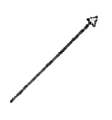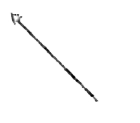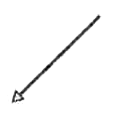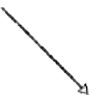Explore topic-wise InterviewSolutions in .
This section includes InterviewSolutions, each offering curated multiple-choice questions to sharpen your knowledge and support exam preparation. Choose a topic below to get started.
| 45251. |
The radioactivity of given sample of whisky due to tritium (half life = 12 yrs) was found to be only 3.125% of that measured in a recently purchased bottle marked "10 yrs old". By how many years ago sample must have been prepared ? |
|
Answer» 20 yrs `rArr (1)/(32)=(1/2)^(t/T) rArr (1/2)^(5) =(1/2)^(t/T)` `t=5T =5 XX 12=60yrs` TOTAL AGE of sample `=60+10=70yrs` |
|
| 45252. |
Thermal radiations are electromagnetic radiation belonging to |
|
Answer» VISIBLE region |
|
| 45253. |
Calculate the energy equivalent of 1 atomic mass unit. |
|
Answer» SOLUTION :We take,m = 1 amu = `1.66 xx 10^(-27)` kg `C = 3 xx 10^(8) ms^(-1)` Then, `E = mc^(2) = 1.66 xx 10^(-27) xx(3 xx (10)^(8))^(2)`J ` = (1.66 xx 10^(-27) xx(3 xx10^(8))^(2))/(1.6 xx 10^(-19)) eV` `E approx 981` MEV `therefore` 1 amu = 931 MeV |
|
| 45255. |
The graph between frequency v of k. X-rays and the atomic number Z |
|
Answer» STRAIGHT LINE |
|
| 45256. |
From the output characteristic shown in fig.calculate the value of current amplification factor of the transistor when V_(CE)=2 V. |
|
Answer» Solution :From the GIVEN CHARACTERISTIC, corresponding to `V_(CE)=2.0V`, note the collector current for two base current (SAY `50muA` and `200muA)`. The corresponding values of` I_c` are `3.0mA` and `9.0mA` RESPECTIVELY. Then `DeltaI_c=9-3=6mA, DeltaI_b=200-50=150muA` `:.` Current amplification FACTOR, `beta_(ac)=(DeltaI_c)/(DeltaI_b)=(6mA)/(150muA)=40` |
|
| 45257. |
A block is gently placed on a conveyor belt moving horizontally with constant speed. After t = 4s, the velocity of the block becomes equal to the velocity of the belt. If the coefficient of friction between the block and the belt is mu = 0.2, then the velocity of the conveyor belt is (g= 10ms^(-2)) |
|
Answer» `2 ms^(-1)` |
|
| 45258. |
When Iron nail is dipped in Copper Sulphate solution |
|
Answer» Blue COLOR CHANGES to green |
|
| 45259. |
A blackened platinum wire is of length 0.1 m and circumference 2 xx 10^(-4) m. calculate the rate at which the wire is loosing energy if it's temperature is 3000 K . |
|
Answer» SOLUTION :Rate of loss energy = `E sigma T^4 XX A` Here e = 1 (blackened surface), `sigma = 5.67 xx 10^(-8) J m^(-2) s^(-1) k^(-4)` T= 3000K A = `(2 pi r) xx l = 2 pi (2 xx 10^(-4) ) xx 0.1 m^2`. |
|
| 45260. |
Two particle X and Y having equal charge, after being accelerated through the same potential difference enter a region of uniform magnetic field and describe circular paths of radii R_1 and R_2 respectively. The ratio of the mass of X to that of Y is |
|
Answer» `(r_1)/(r_2)` |
|
| 45261. |
Crystal diffraction experiments can be performed using X-rays, or electrons accelerated through appropriate voltage. Which probe has greater energy ? (For quantitative comparison, take the wavelength of the probe equal to 1 Å, which is of the order of inter-atomic spacing in the lattice) (m_(e)=9.11xx10^(-31)kg). |
|
Answer» Solution :It is given here that wavelength of probe `lamda=1Å=1xx10^(-10)m` When we use X-rays as the probe, the energy of X-ray photon `E_("X-ray")=hv=(hc)/(lamda)=(6.63xx10^(-34)xx3xx10^(8))/(1xx10^(-10))J=(6.63xx10^(-34)xx3xx10^(8))/(1xx10^(-10)xx1.6xx10^(-19))eV=12.4xx10^(3)eV=12.4keV` When ELECTRON waves are used as the probe, the energy of an electron `E_("electron")=(1)/(2)mv^(2)=(p^(2))/(2m)=(1)/(2m)(h^(2))/(lamda^(2))=((6.63xx10^(-34))^(2))/(2xx.911xx10^(-31)xx(1xx10^(-10))^(2))`J `=((6.63xx10^(-34))^(2))/(2xx9.11xx10^(-31)xx(10^(-10))^(2)xx1.6xx10^(-19))eV=150eV` A SIMPLE comparison of two answers shows `E_("X-ray")gtgtE_("electron")`. |
|
| 45262. |
A magnet of magnetic dipole moment M is released in a uniform magnetic field of induction B from the position shown in the figure.Find (i) Its kinetic energy at theta=90^(@) (ii)its maximum kinetic energy during the motion. (iii) will it perform SHM? oscillation? Periodic motion? What is its amplitude ? |
|
Answer» Solution :(i) Apply energy conservation at `theta=120^(@)` and `theta=90^(@)` `-MB cos 120^(@)+0` `=-MB cos 90^(@)+(K.E)` `KE=(MB)/2` (ii) `K.E.` will be maximum where `P.E.` is minimum. `P.E` is minimum at `theta=0^(@)`.Now apply energy conservation between `theta=120^(@)` and `theta=0^(@)` `-mB cos 120^(@)+0` `=-mB cos 0^(@)+(K.E)_(max)` `(KE)_(max)=3/2MB` The `K.E` is max at `theta=0^(@)` can also be proved by torque method.From `theta=120^(@)` to `theta=0^(@)` the torque always ACTS on the dipole in the same direction (here it is clockwise) so its `K.E.` keeps on increase till `theta=0^(@)`, Beyond that reverses its direction and then `K.E.` starts decreasing `:. theta=0^(@)` is the orientation of `M` to here the maximum `K.E.` (iii) Since `theta` is not small. `:.`the motion is not `S.H.M` but it is OSCILLATORY and periodic amplitude is `120^(@)` |
|
| 45263. |
A magnet is quickly moved in the direction indicated by an arrow between two coils C_(1) and C_(2) as shown in the Fig. 6.34. What will be the direction of induced current in each coil as seen from the magnet ? Justify you answer. |
|
Answer» Solution :In the figure, the magrant NS, with its N-pole facing coil `C_(1)`, is moving away from the coil `C_(1)`. Hence, in accordance with Lenz.s law the INDUCED current will flow in clockwise DIRECTION when seen from the magnet. In such a situation face of coil `C_(1)` facing N-pole of magnet will DEVELOP S POLARITY and will oppose the motion of magnet away from the coil `C_(1)`. Again the magnet NS, with its S-pole facing coil `C_(2)`, is moving towards the coil `C_(2)`. Hence in accordance with Lenz.s law, the induced current will flow in clockwise direction when seen from me magnet. In such a situation, face of coil `C_(2)` facing S-pole of magnet will develop a Spolarity and will oppose the motion of magnet towards the coil `C_(2).` |
|
| 45264. |
A point source of light is 60 cm from a screen and is kept at the focus of a concave mirror which reflects light on the screen. The focal length of the mirror is 20 cm. The ratio of average intensities of the illumination on the screen when the mirror is present and when the mirror is removed is |
|
Answer» `36:1` |
|
| 45265. |
The figure shows the various positionsof smallmagnetised needles P and Q the arrows show thedirectionof theirmagnetic moment whichlowest potenticalenergy amongallthe configurationshown? |
|
Answer» `PQ_(3)` |
|
| 45266. |
Distinguish between resistance, reactance and impedance of an a.c. circuit ? |
|
Answer» Solution :Resistance : It is the opposition OFFERED by a pure resister to the flow of CURRENT in a circuit. Reactance : The non-resistive opposition to the flow of current is called reactance. IMPEDANCE : It is EFFECTIVE resistance of an a.c. circuit containing any two or all the three elements R.L.C. |
|
| 45267. |
A source of light is placed at a distance of 50 cm from a photocell and the stopping potential is found to be V_0 .If the distance between the light source and photocell is made 25 cm, the new stopping potential will be |
|
Answer» `2V_0` |
|
| 45268. |
The electron in a hydrogen atom revolves in an orbit of radius 0.5 Å, constituting a conventional current of 1.1 mA. Calculate the magnetic induction at an axial point 100 Å from the nucleus of theatom. |
|
Answer» Solution :Data: `r=0.5 Å= 5 xx 10^(-11), I=1.1 xx 10^(-3) A, X=100 Å= 10^(-8)m, (mu_(0))/(4pi) = 10^(-7) T.m//A` The magnitude of the magnetic induction at an axial point of a current loop, `B=(mu_(0))/(4pi). (2IA)/(r^(2) + x^(2))^(3//2) ~= (mu_(0))/(4pi)(2IA)/(x^(3))(therefore x^(2) GT gt R^(2))` `=(mu_(0))/(4pi)(2I(pir^(2)))/(x^(3))` `=(10^(-7))(2(1.1 xx 10^(-3))(3.142)(5 xx 10^(-11))^(2))/(10^(-8))^(3)` `=3.142 xx 55 xx 10^(-8) = 1.728 xx 10^(-6)` T |
|
| 45269. |
The work function for a certain metal is 4.2 eV. Will this metal give photoelectric emission for incident radiation of wavelength 330 nm? |
| Answer» SOLUTION :No. because `V LT v_(o)` | |
| 45270. |
A direct vision spectroscope consists of three crown glass prism and two dense flint glass prisms placed alternately with their refracting edges turned in opposite directions. Calculate the net dispersion produced by the prisms. Angle of flint glass prism=10^(@) Numerical Examples in Physics {:(,"Crown glas"," Flint glass"),(mu ("red"),1.513,1.645),(mu("blue"),1.523,1.665):} |
|
Answer» |
|
| 45271. |
The mass of ""_(17)^(35)Cl is 34.9800 u . Calculate its binding energy per nucleon. |
|
Answer» |
|
| 45272. |
A person walks up a stationary excalator in time tl. If he remains stationary on the escalator, then it can take him up in time t_(2). How much time would it take him to walk up the moving escalator? |
|
Answer» Solution :Let L be the length of ascalator. SPEED of man w.r.t esacalator is `v_(me)=(L)/(t_(1))`. Speed of escalator `v_(E)=(L)/(t_(2))` Speed of man with respect to GROUND would be `v_(m)+v_(me)+v_(e)=L((1)/(t_(1))+(1)/(t_(2)))` `:.` The desired time is `t=(L)/(v_(m))=(t_(1)t_(2))/(t_(1)+t_(2))` |
|
| 45273. |
Carbon, silicon and germanium have four valence electrons each. These are characterised by valence and conduction bands separated by energy band gap respectively equal to (E_g)_c, (E_g)_(Si) and (E_g)_(Ge) Which of the following statements is true? |
|
Answer» `E_g)_(SI)LT(E_g)_(Ge)lt(E_g)_c` |
|
| 45274. |
A: Short wave bands are used for transmission of radio waves to a large distance. R: Short waves are reflected by ionosphere. |
|
Answer» |
|
| 45275. |
The heat generated in a circuit is given by Q=I^(2)Rt, where I is current, R is resistance and t is time. If the percentage errors in measuring I,R and t are 2%,1% and 1% respectively, then the maximum error in measuring heat will be : |
|
Answer» `2%` `:.(dQ)/(Q)XX100=2(DI)/(I)xx100+(dR)/(R)xx100+(DT)/(t)xx100` `2xx2%+1%+1%` HENCE `(d)` is correct. |
|
| 45276. |
In Bohr model of hydrogen atom, which of the following is quantised? |
|
Answer» LINEAR VELOCITY of electron |
|
| 45277. |
We are given the job of designing a large horizontal ring that will rotate around a vertical axis and that will have a radius of r = 33.1 m. Passengers will enter through a door in the outer wall of the ring and then stand next to that wall. We decide that for the time interval t = 0 to t = 2.30 s, the angular position theta(t) of a reference line on the ring will be given by theta=ct^(3), with c=6.39xx10^(-2)rad//s^(3). After t = 2.30 s, the angular speed will be held constant until the end of the ride. Once the ring begins to rotate, the floor of the ring will drop away from the riders but the riders will not fall - indeed, they feel as though they are pinned to the wall. For the time t = 2.20 s, let's determine a rider's angular speed omega, linear speed nu, angular acceleration alpha, tangential acceleration a_(t), radial acceleration a_(r), and acceleration veca. |
|
Answer» Solution :(1) The angular speed `omega` is given by Eq. `(omega=d theta//dt)`. (2) The linear speed `nu` (along the circular path) is related to the angular speed (AROUND the rotation axis) by Eq. `(nu=omegar)`. (3) The angular acceleration `alpha` is given by Eq. `(alpha=domega//dt)`. (4) The tangential acceleration `a_(t)` (along the circular path) is related to the angular acceleration (around the rotation axis) by Eq. `(a_(t)=alphar)`. (5) The radial acceleration `a_(r)` is given Eq. `(a_(r)=omega^(2)r)`. (6) The tangential and radial accelerations are the (perpendicular) components of the (full) acceleration `veca`. Calculations: Let.s go through the steps. We first find the angular velocity by taking the time derivative of the given angular position function and then substituting the given time of t = 2.20 s: `omega=(d theta)/(dt)=d/dt(ct^(3))=3ct^(2)` = `3(6.39xx10^(-2)rad//s^(3))(2.20s)^(2)` = 0.928 rad/s. the linear speed just then is `nu=omegar=3ct^(2)r` = `3(6.39xx10^(-2)rad//s^(3))(2.20s)^(2)(33.1m)` = 30.7 m/s. Next, let.s tackle the angular acceleration by taking the time derivative of Eq. `alpha=(domega)/(dt)=d/dt(3ct^(2))=6ct` = `6(6.39xx10^(-2)rad//s^(3))(2.20s)=0.843rad//s^(2)`. The tangential acceleration then follows from Eq. `a_(1)=alphar=6ctr` = `6(6.30xx10^(-2)rad//s^(3))(2.20s)^(2)(33.1m)` = `27.91m//s^(2)~~27.9m//s^(2)`. or 2.8 g Eq. tells us that the tangential acceleration is increasing with time (but it will cut off at t = 2.30 s). From Eq, we write the radial acceleration as `a_(r)=omega^(2)r`. Substituting from Eq. leads us to `a_(r)=(3ct^(2))^(2)r=9C^(2)t^(4)r` = `9(6.39xx10^(-2)rad//s^(3))^(2)(2.20s)^(4)(33.1m)` = `28.49m//s^(2)~~28.5m//s^(2)`, or 2.9 g (which is ALSO reasonable and a bit EXCITING). The radial and tangential accelerations are perpendicular to each other and form the components of the rider.s acceleration `veca`. The magnitude of `veca` is given by `a=sqrt(a_(r)^(2)+a_(t)^(2))` = `sqrt((28.49m//s^(2))^(2)+(27.91m//s^(2))^(2))` `~~39.9m//s^(2)`. or 4.1 g (which is really exciting). All these values are acceptable. To find the orientation of `veca`, we can calculate the angle `theta` SHOWN in Fig. `tantheta=a_(t)/a_(r)`. However, instead of substituting our numerical results, let.s use the algebraic results from Eq. `theta=tan^(-1)((6ctr)/(9c^(2)t^(4)r))=tan^(-1)(2/(3ct^(3)))`. The big advantage of solving for the angle algebraically is that we can then see that the angle (1) does not depend on the ring.s radius and (2) decreases as t goes from 0 to 2.20 s. That is, the acceleration vector `veca` swings toward being radially inward because the radial acceleration (which depends on `t^(4)`) quickly dominates over the tangential acceleration (which depends on only t). At our given time t = 2.20 s, we have `theta="tan"^(-1)2/(3(6.39xx10^(-2)rad//s^(3))(2.20s)^(3))=44.4^(@)`. |
|
| 45278. |
Obtain the equation of thin lens. |
|
Answer» Solution :For refraction at two spherical surfaces of lens, `(n_1)/(-u)+(n_1)/(v)=(n_2-n_1)[(1)/(R_1)-(1)/(R_2)]` `therefore(1)/(-u)+(1)/(v)=((n_2)/(n_1)-1)[(1)/(R_1)-(1)/(R_2)]` [`therefore` DIVIDING by `n_1`] `therefore(1)/(-u)+(1)/(v)=(n_(21)-1)[(1)/(R_1)-(1)/(R_2)]` ... (1) and lens maker.s formula, `1/f=(n_(21)-1)[(1)/(R_1)-(1)/(R_2)]` ... (2) By comparing equation (1) and (2), `1/f=(1)/(-u)+(1)/(v)` or `1/f=1/v-1/u` Here, the DISTANCES are as per sign conventior and this equation is true for real and virtua images of convex and concave lenses. |
|
| 45279. |
Prove that the total current which is the sum of conduction current and displacement current is always continuous and any loss in conduction current (I_C) appears as displacement current (I_D). |
|
Answer» Solution :Consider a volume V in a medium through which currents are flowing. Let `I_c` be the conduction current entering the volume V and `I_c'` be the conduction current leaving the volume V. Then total charges entering and leaving the volume in time dt will be `I_c` and `I_c'`dt. Therefore, the CHARGE ACCUMULATED inside the volume V during time dt is GIVEN by dq(inside V)=`I_cdt-I_c'dt` or `(dq)/(dt)=I_c-I_c'....(i)` From Gauss's Theoram in electrostatics, we have `phi_E=ointvecE.vec(DS)=q/(in_0) ("inside") or in_0 phi_E=q` or `I_d=in_0 (dphi_E)/(dt)=(d (in_0phi_E))/(dt)=(dq)/(dt) ......(ii)` From (i) and (ii), `I_c-I_c'=I_d or I_c=I_d+I_c'` Thus we conclude that the loss of conduction current `(=I_c-I_c')` appears as the DISPLACEMENT current `(I_d)` and conduction current plus displacement current remains constant i.e., `I_c'+I_d`= a constant. |
|
| 45280. |
The focal length of a convex lens is 10 cm. Find its magnifying power when it is used as a magnifying glass to form the image at (i) near point and (ii) far point. |
|
Answer» 3.5, 2.5 |
|
| 45281. |
The focal length of the objective and of the eye- piece of compound microscope are f_(0) and f_(e) respectively. If L is the tube length and d, the least distance of distinct vision, then its angular magnification, when the image is formed at infinity, is |
|
Answer» a. `(1 - (L)/(f_(0)) ) ((D)/(f_(e)))` |
|
| 45282. |
The resistanceof a rectangular blockof copperof dimension2 mm xx2 mm xx 5 m betweentwosquarefacesis 0.02 Omega . Whatist he resistivity ofcopper ? |
|
Answer» `1.6 XX 10^(-6) OMEGA` |
|
| 45283. |
The X-ray beam coming from an X-ray tube will be |
|
Answer» monochromatic |
|
| 45284. |
An inductance of 1 mH, a condenser of 10 muF and a resistance of 50 Omega are connected in series. The reactances of inductors and condensers are same. What will be the reactance of either of them ? |
|
Answer» `5 Omega` `C=10 muF =10xx10^(-6)`F `R=50 Omega "" THEREFORE=10^4` rad/s `X_L=X_C` and `X_L=omegaL` `=10^4 XX 1xx10^(-3)` `omegaL=1/(omegaC)` `therefore X_L=10Omega` `therefore omega^2=1/(LC) "" X_C=1/(OmegaC)` `=1/(1xx10^(-3)xx10xx10^(-6)) "" 1/(10^4xx10xx10^(-6))` `=10^8` `therefore X_C=10 Omega` |
|
| 45285. |
About 5% of the power of a 100 W light bulb is converted to visible radiation . What is the average intensity of visible radiationat a distance of 1 m from the bulb ? Assume that the radiation is emitted isotropically and neglect reflection . |
|
Answer» SOLUTION :(a) `0.4 W//m^(2)`, (B) `0.004 W//m^(2)` |
|
| 45286. |
The magnetic field is…………………….around a conductor in which its magnetic effect can be felt. |
|
Answer» |
|
| 45287. |
One gram mole of nitrogen at 27^(@)C and 1 atm pressure is contained in a vessel and the molecules are moving with their speed. The number of collisions per second which the molecules make with an area of 1m^(2) on the vessel's wall is |
|
Answer» `2xx10^(27)` `THEREFORE n=[(PA)/(2mv_(rms))],"where "v_(rms)=[(3RT)/(M)]^(1//2)` `v_(rms)=sqrt((3xx8.3xx300)/(28xx10^(-3)))=516.8m//s` `m=1g"mole"=(28)/(6.02xx10^(26))` On solving, we get `n=2xx10^(27)` |
|
| 45289. |
What are the dimensions of permittivity? |
| Answer» Answer :B | |
| 45290. |
A combination of two thin lenses in contact is to be made which has the same focal length for blue and red light. . (Such a combination is known as an ' achromatic doublet '). Show that the ratio of their focal lengths (for lengths (for yellow light ) must be equal in magnitude and opposite in sign to the ratio of the dispersive powers of the material of the two lenses. b. Use the results in (a) to suggest a way of removing chromatic aberration of the convex lens of focal length 15 cm , made of flint glass. You are given convexand concave lenses (made of crown glass ) of various focal lengths. The ratio of the dispersive powers of flint glass to crown glass is about 1.5 |
|
Answer» |
|
| 45291. |
The mass of an electron 1/1840 part of mass of proton. When they are subjected to a uniform elecric field, they start accelerating(b) If they start from rest and have the same de Brogile wavelength of 1Å then determine the ratio of their kinetic energies. |
|
Answer» SOLUTION :`lambda_e=h/sqrt(2m_ek_e), lambda_p=h/sqrt(2m_pk_p` SINCE these PARTICLES have same WAVELENGTH `h/sqrt(2m_ek_e)=h/sqrt(2m_pk_p )` `m_ek_e=m_pk_p ` ` k_e/k_p=m_P/m_e=1840` |
|
| 45292. |
The mass of an electron 1/1840 part of mass of proton. When they are subjected to a uniform elecric field, they start accelerating(a) which of them will have large acceleration? |
| Answer» Solution :acceleration `a=(qE)/m or a .a PROP 1/m` IE ELECTRON will have large acceleration | |
| 45293. |
If relative permeability and magnetic susceptibility of paramagnetic substance are mu_(r) and chi_(m) respectively then ...... |
|
Answer» `mu_(r) LT 1, chi_(m) lt 0` |
|
| 45294. |
A proton (mass m) accelerated by a potential difference V flies through a uniform transverse magnetic field B. The field occupies a region of space by width 'd'. If alpha ' be the angle of deviation of proton from initial direction of motion (see figure), the value of sin a will be: |
|
Answer» `qVsqrt( (pd )/(2m))` |
|
| 45295. |
What is modulation index? What is importance of modulation index? |
| Answer» SOLUTION :The degree to which the carrier WAVE is MODULATED is called MODULATION index. The modulation index deermines the strength and quality of the transmitted SIGNAL. When modulation index is high, the reception will be strong and clear. | |
| 45296. |
The given figure represents a portion of a wire in a circuit. A current is flowing in the wire in the direcnon shown. Under the convention that is positive charge that flows, the electric field point field in the direction of the charge rent. There will be some charge accumulation at the bend to change the direction of the electric field. What is the direction of the electric field due to charges at the bend? |
|
Answer»
|
|
| 45297. |
A infinitely long solid non-conducting cylinder has radius 'r' and charge density ρ Cm^(-3). Electric field at distance x from its centre is (x lt r) |
|
Answer» `(PX)/(3epsilon_(0))` |
|
| 45298. |
If the amplitude of a simple pendulum is doubled, how many times will the value of its maximum velocity be that of the maximum velocity in initial |
|
Answer» `1//2` |
|
| 45299. |
There is force of attraction between two unlike charges because lines of force have tendency |
|
Answer» to SHRINK ALONG their length and they are under tension |
|
| 45300. |
If a voltage to an X-ray tube is increased to 1.5 times the minimum wavelength (lamda_(min)) of an X-ray continuous spectrum shifts by Delta lamda = 26 pm. The initial voltage applied to the tube is |
|
Answer» `~~ 10 KV` |
|



